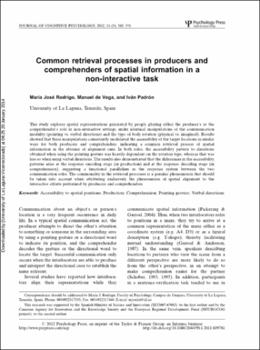Common retrieval processes in producers and comprehenders of spatial information in a noninteractive task
Fecha
2012Resumen
This study explores spatial representations generated by people playing either the producer’s or the
comprehender’s role in non-interactive settings, under identical manipulations of the communication
modality (pointing vs. verbal directions) and the type of body rotation (physical vs. imagined). Results
showed that these manipulations consistently modulated the accessibility of the target locations in similar
ways for both producers and comprehenders, indicating a common retrieval process of spatial
information in the absence of alignment cues. In both roles, the accessibility pattern to directions
obtained when using the pointing gesture was heavily dependent on the rotation type, whereas that was
less so when using verbal directions. The results also demonstrated that the differences in the accessibility
patterns arise at the response encoding stage (in production) and at the response decoding stage (in
comprehension), suggesting a functional parallelism in the response system between the two
communication roles. The commonality in the retrieval processes is a genuine phenomenon that should
be taken into account when attributing exclusively the phenomenon of spatial alignment to the
interactive efforts performed by producers and comprehenders.





